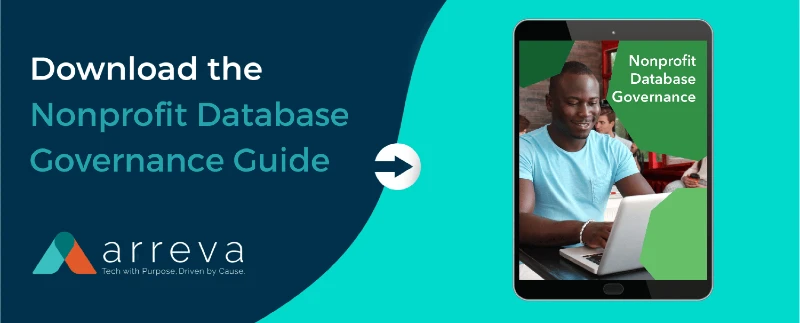5 Essential Steps to Building a Data-Driven Fundraising Program

In When Good Data Goes Bad, we talked about the ways faulty data and data management can harm your donor relationships. But a fully integrated donor data management system not only works to prevent damaging missteps, but it also streamlines tasks ordinarily handled by multiple applications, increasing efficiency and making your job—raising money to fund your organization’s important work—easier. A data-driven fundraising program is essential, and a data-driven organizational culture as much or more so.
What “Data-Driven” Means in Practice
“Data” is just a fancy word for “information. A data-driven fundraising program depends on the ability to gather accurate and complete information about your donors, store it safely and retrieve it easily, update it efficiently, and learn from and employ the information to best effect in your fundraising efforts. Complete data means knowing who your donors are and where they live and work, how they prefer to engage, their donation history with you (and if possible, with other organizations), and anything else relevant to the scope of your work.
A data-driven fundraising program is most effective within a data-driven culture: a culture in which pertinent data and analytics are readily visible to and consistently employed by teams throughout your organization, and one in which decisions are based in evidence derived from real, tangible facts. In a data-driven culture, not only is the information you’ve collected as accurate as possible and transparent to teams within your org, but teams also have access to the tools with which to analyze donor and program data and measure results, and they’re trained in processes that encourage staff at every level to put that data to work toward meeting goals.
Making data and analyses visible via regular email reports, graphic presentations, interactive dashboards, and even slideshows on monitors here and there in work or meeting areas can mean that staff in all departments become more invested in driving results, and thus, your data-driven culture evolves. And organizations that successfully establish a data-driven culture report “improved financial performance, increased productivity, reduced risk, and faster decision making” according to a report from the Harvard Business Review.
"Leading analytics users embrace a host of strategies, which evolve into best practices to create an ‘analytics ecosystem’ in their department or organization over time.”
-The Evolution of Decision Making: How Leading Organizations Are Adopting a Data-Driven Culture, Harvard Business Review, 2012
Creating Your Data-Driven Program
- Establish: Build a Data Infrastructure
- Collect: Gather/Migrate Data
- Analyze: Evaluate Initial Data
- Test & Measure: Ask Questions and Measure Results
- Rinse and Repeat
1. Establish Your Data Infrastructure
The first step in building your data-driven fundraising program is finding the right software to help you manage your donor information and relationships. Before establishing a data infrastructure, many organizations rely on data from various sources stored on multiple platforms, each with a different access point, which is not only inefficient, it increases the likelihood of duplicated or erroneous data. A good software solution will make migrating your current data, in whatever form, a painless process, while providing an integrated solution to data collection, management, and analysis. It will help you collate, update, access, and analyze your data easily and efficiently in one place, all while keeping it secure to protect your donors and your reputation.
2. Collect Relevant Data
It’s important to collect as much relevant information about your donors as you can, but the keyword here is “relevant.” Too much extraneous data—information that doesn’t affect your fundraising bottom line—may cloud your view and prevent you from seeing useful patterns. Determine what data you need in order to measure success and then establish standards and processes to ensure that you’re collecting complete and accurate information at every opportunity.
3. Analyze Your Data
Knowing what metrics are key to your goals, and having tools that allow you to easily view, compare, and contrast those metrics, makes all the difference in your ability to put your data to work for you. And as we’ve mentioned, transparency is key to creating an organizational culture that values and engages with data on every level; the more people within your organization who have access to your data and analyses, the more opportunities you create for teams to set and achieve measurable goals and successes.
4. Test and Measure
Now that you’ve established your infrastructure and analyzed your initial data, you’re ready to employ the evidence your data has revealed in order to make informed decisions, set achievable goals, and measure success. You can ask questions about what’s working and what might work even better, test your hypotheses, record and measure results, and use the answers to drive your fundraising successes.
Are donors more likely to give as the result of a fundraising email or a Facebook post? How are peer-to-peer fundraisers performing when compared to other types of campaigns? Which payment option do most donors prefer, and are you making it easy enough for them to donate the way they want to? Questions like these, when tested in practice and the resulting data measured and analyzed and put to use, lead to more successful fundraising in the future.
5. Rinse & Repeat
Like any program, you're building the trick is repetition. As long as you've set clear goals, established good data infrastructure, understood what data is relevant to your program -- and set up specific guidelines for how that data is entered, you are consistently analyzing your data and using it to test your hypotheses and measuring your results you're ready to put your data-driven fundraising process into action. Make sure those things stick as you move your fundraising program forward and you'll be able to build onto your data each time and make the incremental changes you need to supercharge your fundraising program.
Next up, we’ll talk about managing your data and how more data can mean more challenges when it comes to database management, and ways to keep your data under control.


